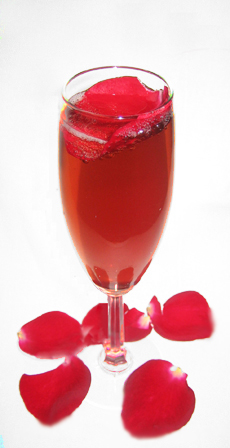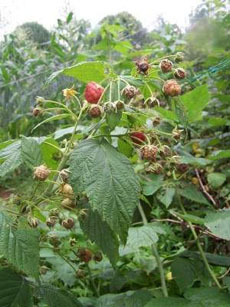Preparation
1. STIR lightly together in mixing glass (heavy stirring will break the Champagne bubbles).
2. STRAIN into a chilled Champagne flute.
3. TOP with extra Champagne.
WHAT IS ROSE SORBET/SHERBET or FALUDEH?
The favorite Persian frozen dessert, rose sorbet is a rare and wonderful experience, made from cooked rose petals. You step into the very essence of the flower. In am authentic Middle Eastern faludeh, fine threads of starch noodles (like rice noodles, but made of wheat) are added for visual beauty and an appealing crunch.
Next time, don’t send a dozen roses: send a few quarts of rose sorbet from Los Angeles ice cream artisan Mashti Malone.
In addition to flavoring Love Potion No. 299, rose sorbet is a great palate cleanser between fish and meat courses, a dazzling dessert, and an invigorating refreshment. In Persian circles, faludeh (the Persian word for rose sorbet), is as ubiquitous as the ice cream is in the U.S. It is generally served in a bowl, garnished with sour cherries and/or a drizzle of sour cherry syrup, a squirt of lime juice, and pistachios.
It would make an absolutely great Valentine’s Day dessert, followed by a Love Potion No. 299.
FOOD HISTORY: THE WORD “SORBET”
Sorbet originated in China up to 4,000 years ago as snow and ice flavored with syrup. Through trade, the recipe arrived in Persia. Persians invented a dessert made of rosewater and vermicelli—faludeh—around 400 B.C.E. Alexander The Great brought the recipe back to Greece after he conquered Persia in 330 B.C.E. The recipe became a favorite with the Roman emperors.
According to TurkishCookbook.com, sherbet is served both as a liquid—the rose version of lemonade, served on hot summer days—and a frozen dessert. Ottoman Turks drank sherbet during meals as we drink water. As with lemonade, sherbet is made from fruit juices (or extracts of flowers or herbs) combined with sugar, water and ice.
See the History Of Ice Cream (and its predecessor, sherbet).
CHECK OUT WHAT’S HAPPENING ON OUR HOME PAGE, THENIBBLE.COM.
|




